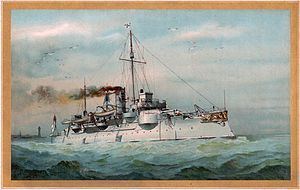Name Siegfried Completed 19 April 1890 Decommissioned Hulked, 1916 Construction started 1888 Length 79 m Displacement 3.5 million kg | Laid down 1888 Commissioned 29 April 1890 Struck 17 June 1919 Launched 10 August 1889 Weight 3,500 tons | |
 | ||
Builder Friedrich Krupp Germaniawerft | ||
SMS Siegfried was the lead ship of the six-member Siegfried class of coastal defense ships (Küstenpanzerschiffe) built for the German Imperial Navy. Her sister ships were Beowulf, Frithjof, Heimdall, Hildebrand, and Hagen. Siegfried was built by the Germaniawerft shipyard between 1888 and 1890, and was armed with a main battery of three 24-centimeter (9.4 in) guns. She served in the German fleet throughout the 1890s and was rebuilt in 1903 - 1904. She served in the VI Battle Squadron after the outbreak of World War I in August 1914, but saw no action. Siegfried was demobilized in 1915 and used as a barracks ship thereafter. She was ultimately broken up for scrap in 1920.
Contents
Design
Siegfried was 79 meters (259 ft) long overall and had a beam of 14.90 m (48.9 ft) and a maximum draft of 5.74 m (18.8 ft). She displaced 3,741 long tons (3,801 t) at full combat load. Her propulsion system consisted of two vertical 3-cylinder triple expansion engines. Steam for the engines was provided by four coal-fired boilers. The ship's propulsion system provided a top speed of 14.9 knots (27.6 km/h; 17.1 mph) and a range of approximately 1,490 nautical miles (2,760 km; 1,710 mi) at 10 knots (19 km/h; 12 mph). Siegfried had a crew of 20 officers and 256 enlisted men.
The ship was armed with three 24 cm K L/35 guns mounted in three single gun turrets. Two were placed side by side forward, and the third was located aft of the main superstructure. They were supplied with a total of 204 rounds of ammunition. The ship was also equipped with six 8.8 cm SK L/30 guns in single mounts. Siegfried also carried four 35 cm (14 in) torpedo tubes, all in swivel mounts on the deck. One was at the bow, another at the stern, and two amidships. The ship was protected by an armored belt that was 240 mm (9.4 in) amidships, and an armored deck that was 30 mm (1.2 in) thick. The conning tower had 80 mm (3.1 in) thick sides.
Service history
Siegfried was laid down in 1888 at the Germaniawerft shipyard in Kiel. She was launched on 10 August 1889, and completed on 19 April 1890. She was commissioned into the fleet on 29 April, and joined the I Division of the German fleet, along with the older ironclads Baden, Bayern, and Oldenburg, under Vizeadmiral Karl Deinhard. The I Division participated in several fleet maneuvers in 1891, where they typically served as the German side in the war games. Siegfried did not participate in the 1892 maneuvers, having been replaced in the I Division by her recently-commissioned sister ship Beowulf.
Over the winter of 1892 - 1893, Siegfried and Beowulf joined the elderly ironclads König Wilhelm and Deutschland for a winter training cruise in the Mediterranean Sea. Siegfried again sat out the 1893 fleet maneuvers, instead of her sister Frithjof, which had just joined the fleet. In the 1897 maneuvers, Siegfried and all five of her sister ships formed the III Division. In 1898, Siegfried again participated in the annual summer maneuvers in the III Division, along with Beowulf and Hildebrand. Her other three sisters were assigned to the IV Division. During the 1900 summer maneuvers, Siegfried served in the simulated hostile squadron, alongside Heimdall, Hildebrand, and Ägir.
Siegfried served on active duty until 1903, when she was withdrawn from service. Starting in 1903, she was taken into drydock at the Kaiserliche Werft shipyard in Danzig for an extensive reconstruction. The ship was lengthened to 86.13 m (282.6 ft), which increased displacement to 4,237 t (4,170 long tons; 4,670 short tons). Her old boilers were replaced with eight new Marine type boilers, and a second funnel was added. Her secondary battery was increased to ten 8.8 cm guns, and the 35 cm torpedo tubes were replaced with three 45 cm (18 in) tubes. Work was completed by 1904.
She was brought back on active duty at the outbreak of World War I in August 1914, and mobilized into the VI Battle Squadron for coastal defense, along with her sister ships. On 31 August 1915, the VI Battle Squadron was demobilized, and Siegfried's crew was transferred to other warships. She was then used as a barracks ship in Wilhelmshaven, a role she filled until the end of the war. On 17 June 1919, she was stricken from the naval register. The navy planned to convert her into a salvage ship, but the plan was abandoned and she was instead sold for 425,000 marks to H. Peters in Wewelsfleth. Siegfried was broken up for scrap the following year in Kiel-Nordmole.
